Contents
Inside This Manual
The HSPICE Documentation Set
Conventions
Customer Support
1 Overview of MOSFET Models
Overview of MOSFET Model Types
Selecting Models
Selecting MOSFET Model LEVELs
Selecting MOSFET Capacitors
Selecting MOS Diodes
Searching Models as Function of W, L
Setting MOSFET Control Options
Scaling Units
Scaling for LEVEL 25 and 33
Bypassing Latent Devices
General MOSFET Model Statement
MOSFET Output Templates
2 Technical Summary of MOSFET Models
Nonplanar and Planar Technologies
Nonplanar Technology
Planar Technology:
Field Effect Transistors
MOSFET Equivalent Circuits
Equation Variables
Using MOSFET Current Convention
Using MOSFET Equivalent Circuits
MOSFET Diode Models
Selecting MOSFET Diode Models
Enhancing Convergence
MOSFET Diode Model Parameters
Using an ACM=0 MOS Diode
Calculating Effective Areas and Peripheries
Calculating Effective Saturation Current
Calculating Effective Drain and Source Resistances
Using an ACM=1 MOS Diode
Calculating Effective Areas and Peripheries
Calculating Effective Saturation Current
Calculating Effective Drain and Source Resistances
Using an ACM=2 MOS Diode
Calculating Effective Areas and Peripheries
Calculating Effective Saturation Currents
Calculating Effective Drain and Source Resistances
Using an ACM=3 MOS Diode
Calculating Effective Areas and Peripheries
Effective Saturation Current Calculations
Effective Drain and Source Resistances
MOS Diode Equations
DC Current
Using MOS Diode Capacitance Equations
Common Threshold Voltage Equations
Common Threshold Voltage Parameters
Calculating PHI, GAMMA, and VTO
MOSFET Impact Ionization
Calculating the Impact Ionization Equations
Calculating Effective Output Conductance
Cascoding Example
Cascode Circuit
MOS Gate Capacitance Models
Selecting Capacitor Models
Transcapacitance
Operating Point Capacitance Printout
Element Template Printout
Calculating Gate Capacitance
Input File
Calculations
Results
Plotting Gate Capacitances
Capacitance Control Options
Scaling
MOS Gate Capacitance Model Parameters
Specifying XQC and XPART for CAPOP=4, 9, 11, 12, 13
Overlap Capacitance Equations
CAPOP=0 - SPICE Meyer Gate Capacitances
Gate-Bulk Capacitance (cgb)
Gate-Source Capacitance (cgs)
Gate-Drain Capacitance (cgd)
CAPOP=1 - Modified Meyer Gate Capacitances
Gate-Bulk Capacitance (cgb)
Gate-Source Capacitance (cgs)
Gate-Drain Capacitance (cgd)
CAPOP=2-Parameterized Modified Meyer Capacitance
Gate-Bulk Capacitance (cgb)
Gate-Source Capacitance (cgs)
Gate-Drain Capacitance (cgd)
CAPOP=3 - Gate Capacitances (Simpson Integration)
CAPOP=4 - Charge Conservation Capacitance Model
CAPOP=5 - No Gate Capacitance
CAPOP=6 - AMI Gate Capacitance Model
CAPOP=13 - BSIM1-based Charge-Conserving Gate Capacitance Model
CAPOP=39 - BSIM2 Charge-Conserving Gate Capacitance Model
Calculating Effective Length and Width for AC Gate Capacitance
Noise Models
Temperature Parameters and Equations
Temperature Parameters
MOS Temperature Coefficient Sensitivity Parameters
Temperature Equations
Energy Gap Temperature Equations
Saturation Current Temperature Equations
MOS Diode Capacitance Temperature Equations
Surface Potential Temperature Equations
Threshold Voltage Temperature Equations
Mobility Temperature Equations
Channel Length Modulation Temperature Equation
Calculating Diode Resistance Temperature Equations
Reliability Analysis for HSPICE MOSFET Devices
3 Common MOSFET Model Parameters
Basic MOSFET Model Parameters
Summary of Basic MOSFET Model Parameters
Effective Width and Length Parameters
Threshold Voltage Parameters
Mobility Parameters
4 Standard MOSFET Models: Level 1 to 40
LEVEL 1 IDS: Schichman-Hodges Model
LEVEL 1 Model Parameters
LEVEL 1 Model Equations
IDS Equations
Effective Channel Length and Width
LEVEL 2 IDS: Grove-Frohman Model
LEVEL 2 Model Parameters
LEVEL 2 Model Equations
IDS Equations
Effective Channel Length and Width
Threshold Voltage, vth
Saturation Voltage, vdsat
Mobility Reduction, ueff
Channel Length Modulation
Subthreshold Current, Ids
LEVEL 3 IDS: Empirical Model
LEVEL 3 Model Parameters
LEVEL 3 Model Equations
IDS Equations
Effective Channel Length and Width
Threshold Voltage, vth
Saturation Voltage, vdsat
Effective Mobility, ueff
Channel Length Modulation
Subthreshold Current, Ids
Compatibility Notes
Synopsys Device Model versus SPICE3
Temperature Compensation
Simulation results:
LEVEL 4 IDS: MOS Model
LEVEL 5 IDS Model
LEVEL 5 Model Parameters
IDS Equations
Effective Channel Length and Width
Threshold Voltage, vth
Saturation Voltage, vdsat
Mobility Reduction, UBeff
Channel Length Modulation
Subthreshold Current, Ids
Depletion Mode DC Model ZENH=0
IDS Equations, Depletion Model LEVEL 5
Threshold Voltage, vth
Saturation Voltage, vdsat
Mobility Reduction, UBeff
Channel Length Modulation
Subthreshold Current, Ids
LEVEL 6/LEVEL 7 IDS: MOSFET Model
LEVEL 6 and LEVEL 7 Model Parameters
UPDATE Parameter for LEVEL 6 and LEVEL 7
LEVEL 6 Model Equations, UPDATE=0,2
IDS Equations
Effective Channel Length and Width
Threshold Voltage, vth
Single-Gamma, VBO=0
Effective Built-in Voltage, vbi
Multi-Level Gamma, VBO>0
Effective Built-in Voltage, vbi for VBO>0
Saturation Voltage, vdsat (UPDATE=0,2)
Saturation Voltage, vsat
LEVEL 6 IDS Equations, UPDATE=1
Alternate DC Model (ISPICE model)
Subthreshold Current, ids
Effective Mobility, ueff
Channel Length Modulation
ASPEC Compatibility
LEVEL 7 IDS Model
LEVEL 8 IDS Model
LEVEL 8 Model Parameters
LEVEL 8 Model Equations
IDS Equations
Effective Channel Length and Width
Effective Substrate Doping, nsub
Threshold Voltage, vth
Saturation Voltage vdsat
Effective Mobility, ueff
Channel Length Modulation
Subthreshold Current Ids
LEVEL 27 SOSFET Model
LEVEL 27 Model Parameters
Non-Fully Depleted SOI Model
Model Components
Obtaining Model Parameters
Fully Depleted SOI Model Considerations
LEVEL 38 IDS: Cypress Depletion Model
LEVEL 38 Model Parameters
LEVEL 38 Model Equations
IDS Equations
Threshold Voltage, vth
Saturation Voltage, vdsat
Mobility Reduction, UBeff
Channel Length Modulation
Subthreshold Current, ids
Example Model File
Mobility Model
Body Effect
Saturation
LEVEL 40 HP a-Si TFT Model
Using the HP a-Si TFT Model
Effect of SCALE and SCALM
Noise Model
DELVTO Element
Device Model and Element Statement Example
LEVEL 40 Model Equations
Cutoff Region (NFS=0, vgs £ von)
Noncutoff Region (NFS ¹ 0)
Cgd, Cgs
LEVEL 40 Model Topology
References
5 Standard MOSFET Models: Levels 50 to 69
Level 50 Philips MOS9 Model
JUNCAP Model Parameters
Using the Philips MOS9 Model
Model Statement Example
Level 55 EPFL-EKV MOSFET Model
Single Equation Model
Effects Modeled
Coherence of Static and Dynamic Models
Bulk Reference and Symmetry
EKV Intrinsic Model Parameters
Static Intrinsic Model Equations
Parameter Preprocessing
Bulk Referenced Intrinsic Voltages
Effective Channel Length and Width
Short Distance Matching
Reverse Short-channel Effect (RSCE)
Effective Gate Voltage Including RSCE
Effective substrate factor including charge-sharing for short and narrow channels
Pinch-off Voltage Including Short-Channel and Narrow-Channel Effects
Slope Factor
Large Signal Interpolation Function
Forward Normalized Current
Velocity Saturation Voltage
Drain-to-source Saturation Voltage for Reverse Normalized Current
Channel-length Modulation
Equivalent Channel Length Including Channel-length Modulation and Velocity Saturation
Reverse Normalized Current
Transconductance Factor and Mobility Reduction Due to Vertical Field
Specific Current
Drain-to-source Current
Transconductances
Impact Ionization Current
Quasi-static Model Equations
Dynamic Model for the Intrinsic Node Charges
Intrinsic Capacitances
Intrinsic Noise Model Equations
Thermal Noise
Flicker Noise
Operating Point Information
Numerical values of model internal variables
Transconductance efficiency factor
Early voltage
Overdrive voltage
SPICE-like threshold voltage
Saturation voltage
Saturation / non-saturation flag:
Estimation and Limits of Static Intrinsic Model Parameters
Model Updates Description
Revision I, September 1997
Revision II, July 1998
Corrections from EPFL R11, March, 1999
Corrections from EPFL R12, July 30, 1999
Level 58 University of Florida SOI
Level 58 FD/SOI MOSFET Model Parameters
Level 58 NFD/SOI MOSFET Model Parameters
Notes:
Level 58 Template Output
Level 61 RPI a-Si TFT Model
Model Features
Using Level 61 with Synopsys Simulators
Equivalent Circuit
Model Equations
Drain Current
Temperature Dependence
Capacitance
Level 62 RPI Poli-Si TFT Model
Model Features
Using Level 62 with Synopsys Simulators
Equivalent Circuit
Model Equations
Drain Current
Threshold Voltage
Temperature Dependence
Capacitance
Geometry Effect
Self Heating
Level 63 Philips MOS11 Model
Using the Philips MOS11 Model
Description of Parameters
Level 64 STARC HiSIM Model
Level 69 PSP100 Series Model
General Features
PSP100.1 Model
PSP101.0 Model
PSP102.0 Model
PSP102.1 Model
Usage in HSPICE
Instance Parameter Lists
Model Parameter Lists
Source- and Drain-Bulk Junction Model Parameters
6 BSIM MOSFET Models: Levels 13 to 39
LEVEL 13 BSIM Model
BSIM Model Features
LEVEL 13 Model Parameters
Sensitivity Factors of Model Parameters
.MODEL VERSION Changes to BSIM Models
LEVEL 13 Equations
Effective Channel Length and Width
IDS Equations
Threshold Voltage
Saturation Voltage (vdsat)
ids Subthreshold Current
Resistors and Capacitors Generated with Interconnects
Temperature Effect
Charge-Based Capacitance Model
Regions Charge Expressions
Preventing Negative Output Conductance
Calculations Using LEVEL 13 Equations
Compatibility Notes
Model Parameter Naming
SPICE/Synopsys Model Parameter Differences
Parasitics
Temperature Compensation
UPDATE Parameter
IDS and VGS Curves for PMOS and NMOS
LEVEL 28 Modified BSIM Model
LEVEL 28 Features
LEVEL 28 Model Parameters
Notes:
Sensitivity Factors of Model Parameters
LEVEL 28 Model Equations
Effective Channel Length and Width
Threshold Voltage
Effective Mobility
Saturation Voltage (vdsat)
Transition Points
Strong Inversion Current
Weak Inversion Current
LEVEL 39 BSIM2 Model
LEVEL 39 Model Parameters
Other Device Model Parameters that Affect BSIM2
LEVEL 39 Model Equations
Effective Length and Width
Geometry and Bias of Model Parameters
Compatibility Notes
SPICE3 Flag
Temperature
Parasitics
Selecting Gate Capacitance
Unused Parameters
.MODEL VERSION Changes to BSIM2 Models
Preventing Negative Output Conductance
Charge-based Gate Capacitance Model (CAPOP=39)
Synopsys Device Model Enhancements
Temperature Effects
Alternate Gate Capacitance Model
Impact Ionization
Parasitic Diode for Proper LDD Modeling
Skewing of Model Parameters
HSPICE Optimizer
Modeling Guidelines, Removing Mathematical Anomalies
Modeling Example
Typical BSIM2 Model Listing
Common SPICE Parameters
Synopsys Parameters
References
7 MOSFET Models: Levels 47 to 71
Level 47 BSIM3 Version 2 MOS Model
Using the BSIM3 Version 2 MOS Model
Level 47 Notes
Leff and Weff Equations for BSIM3 Version 2.0
Level 47 Model Equations
Threshold Voltage
Mobility of Carrier
Drain Saturation Voltage
Linear Region
Saturation Region
Drain Current
Subthreshold Region
Transition Region (for subthMod=2 only)
Temperature Compensation
PMOS Model
Level 49 and 53 BSIM3v3 MOS Models
Selecting Model Versions
Recommended BSIM3v3 Version
Version 3.2 Features
Version 3.3 Features
Nonquasi-Static (NQS) Model
HSPICE Junction Diode Model and Area Calculation Method
TSMC Diode Model
BSIM3v3 STI/LOD
Parameter Differences
Noise Model
Performance Improvements
Reduced Parameter Set BSIM3v3 Model (BSIM3-lite)
Parameter Binning
BSIM3v3 WPE Model
BSIM3v3 Ig Model
Charge Models
VFBFLAG
Printback
Mobility Multiplier
Using BSIM3v3
Level 49, 53 Model Parameters
Level 49/53 Notes:
Parameter Range Limits
Level 49, 53 Equations
.MODEL CARDS NMOS Model
PMOS Model
Level 54 BSIM4 Model
Version 4.5 Features
General Syntax for BSIM4 Model
Improvements Over BSIM3v3
TSMC Diode Model
BSIM4 Juncap2 Model
BSIM4 STI/LOD
LMLT and WMLT in BSIM4
HSPICE Junction Diode Model and ACM
Level 54 BSIM4 Template Output List
Version 4.6 Features
Level 57 UC Berkeley BSIM3-SOI Model
General Syntax for BSIM3-SOI Model
Level 57 Model Parameters
Level 57 Notes:
Level 57 Template Output
Level 57 Updates to BSIM3-SOI PD versions 2.2, 2.21, and 2.22
Using BSIM3-SOI PD
UCB BSIMSOI3.1
Ideal Full-Depletion (FD) Modeling
Gate Resistance Modeling
Gate Resistance Equivalent Circuit
Enhanced Binning Capability
Bug Fixes
New Features in BSIMSOIv3.2
BSIMSOI3.2 Noise Model
Model Parameters in BSIMSOIv3.2
Level 59 UC Berkeley BSIM3-SOI FD Model
General Syntax for BSIM3-SOI FD Model
Level 59 Model Parameters
Level 59 Template Output
Level 60 UC Berkeley BSIM3-SOI DD Model
Model Features
General Syntax for BSIM3-SOI DD Model
Level 60 BSIMSOI Model Parameters
Level 65 SSIMSOI Model
Using Level 65 with Synopsys Simulators
General Syntax for SSIMSOI
Level 66 HSPICE HVMOS Model
Level 70 BSIMSOI4.0 Model Parameters
General Syntax for BSIMSOI4.0 Model
BSIMOI4.0 Model Parameters
Level 71 TFT Model
General Syntax for the Level 71 Model
Argument Descriptions
Level 71 Model Parameters
BSIM3 and BSIM4 Supported Instance Parameters
8 Custom Common Model Interface
Overview of Custom CMI
Directory Structure
Running Simulations Using Custom CMI Models
Adding Proprietary MOS Models
MOS Models on Unix Platforms
Creating the Directory Environment
Preparing Model Routine Files
Compiling the Shared Library
Choosing a Compiler
Runtime Shared Library Path
Troubleshooting
MOS Models on PC Platforms
Testing Custom CMI Models
Model Interface Routines
Interface Variables
pModel, pInstance
CMI_ResetModel
CMI_ResetInstance
CMI_AssignModelParm
CMI_AssignInstanceParm
CMI_SetupModel
CMI_SetupInstance
CMI_Evaluate
CMI_DiodeEval
CMI_Noise
CMI_PrintModel
CMI_FreeModel
CMI_FreeInstance
CMI_WriteError
CMI_Start
CMI_Conclude
Custom CMI Function Calling Protocol
Internal Routines
Extended Topology
Enhancements for Custom CMI
Gate Direct Tunneling Current
Additional Instance Parameter Support
An Extension to Support BSIM4 Topology
Activating These Enhancements
Conventions
Bias Polarity, for N- and P-channel Devices
Source-Drain Reversal Conventions
Thread-Safe Model Code
A Finding Device Libraries
The HSPICE Automatic Model Selector
B Comparing MOS Models
History and Motivation
Synopsys Device Model Enhancements
LEVEL 2
LEVEL 3
LEVEL 13 (BSIM)
LEVEL 28
LEVEL 39
Future for Model Developments
Model Equation Evaluation Criteria
Potential for Good Fit to Data
Measure: Number of Parameters
Measure: Minimal Number of Parameters
Ease of Fit to Data
Measure: Physical Percentage of Parameters
Robustness and Convergence Properties
Behavior Follows Devices in All Circuit Conditions
Ability to Simulate Process Variation
Gate Capacitance Modeling
Outline of Optimization Procedure
Examples of Data Fitting
LEVEL 28, 2, 3-Ids Model vs. Data
LEVEL 13, 28, 39 - Ids Model vs. Data
LEVEL 2, 3, 28-Gds Model vs. Data
LEVEL 13, 28, 39-Gds Model versus Data
LEVEL 2, 3, 28- Ids Model versus Data
LEVEL 13, 28, 39-Ids Model versus Data
LEVEL 2, 3, 28-Gm/Ids Model versus Data
LEVEL 13, 28, 39-Gm/Ids Model versus Data
Gds versus Vds at Vgs=4, Vbs=0
Gm/Ids vs. Vgs at Vds=0.1, Vbs=0, 2
Gm/Ids versus Vgs at Vds=0.1, Vbs=0
Index
A
B
C
D
E
F
G
H
I
J
L
M
N
O
P
Q
R
S
T
U
V
W
X
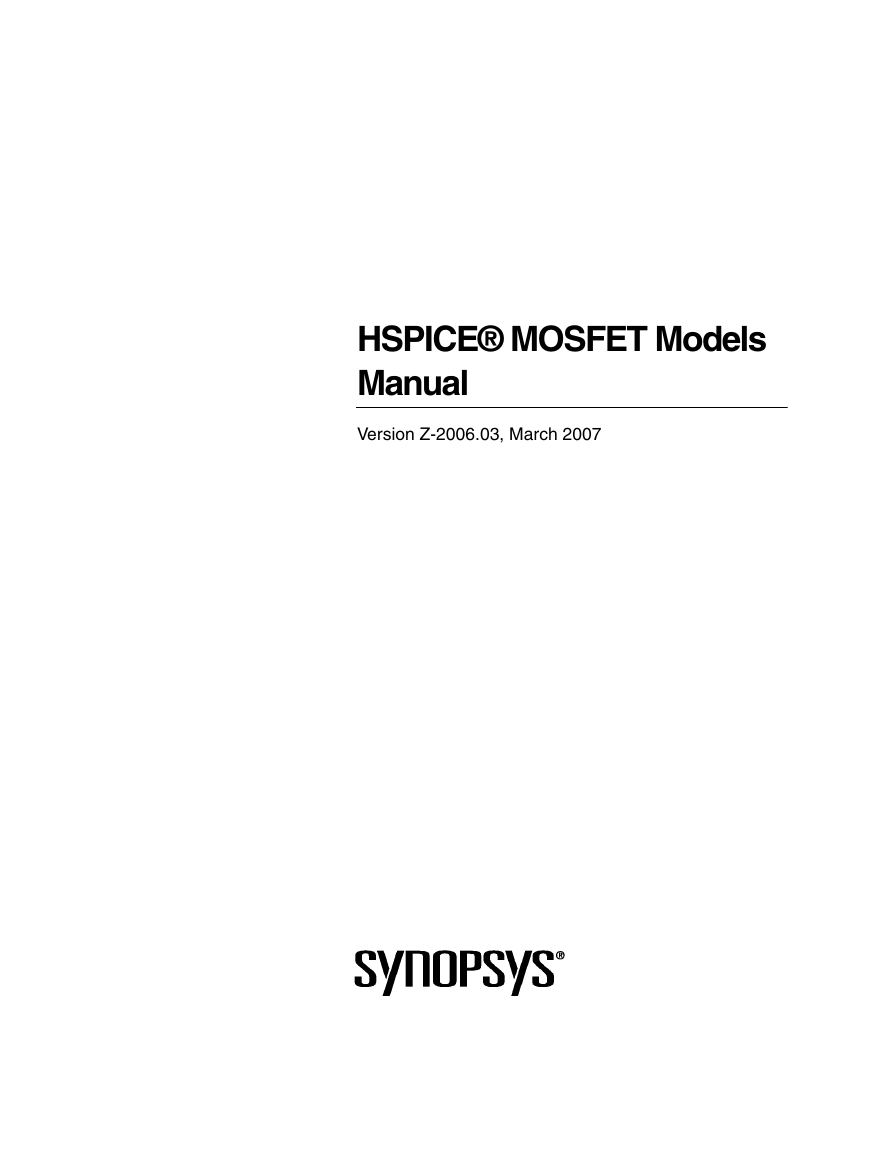

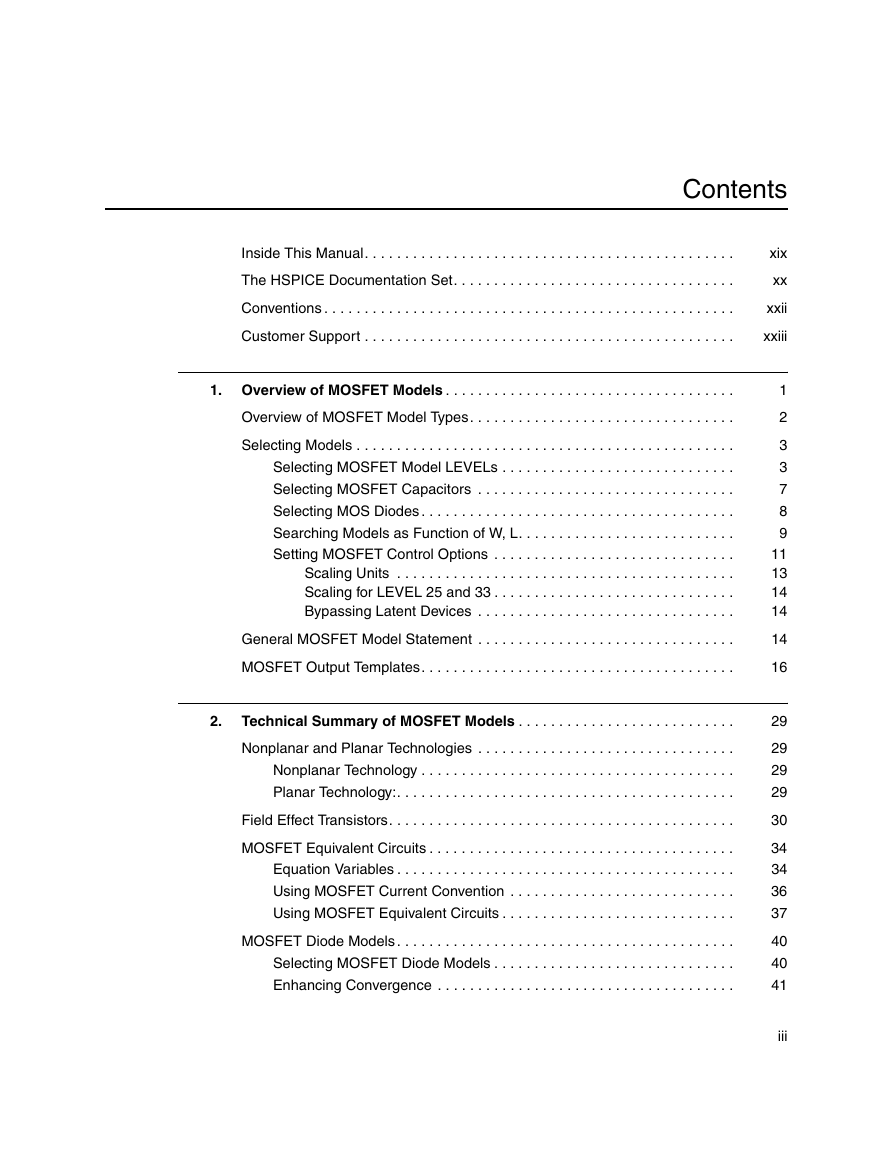
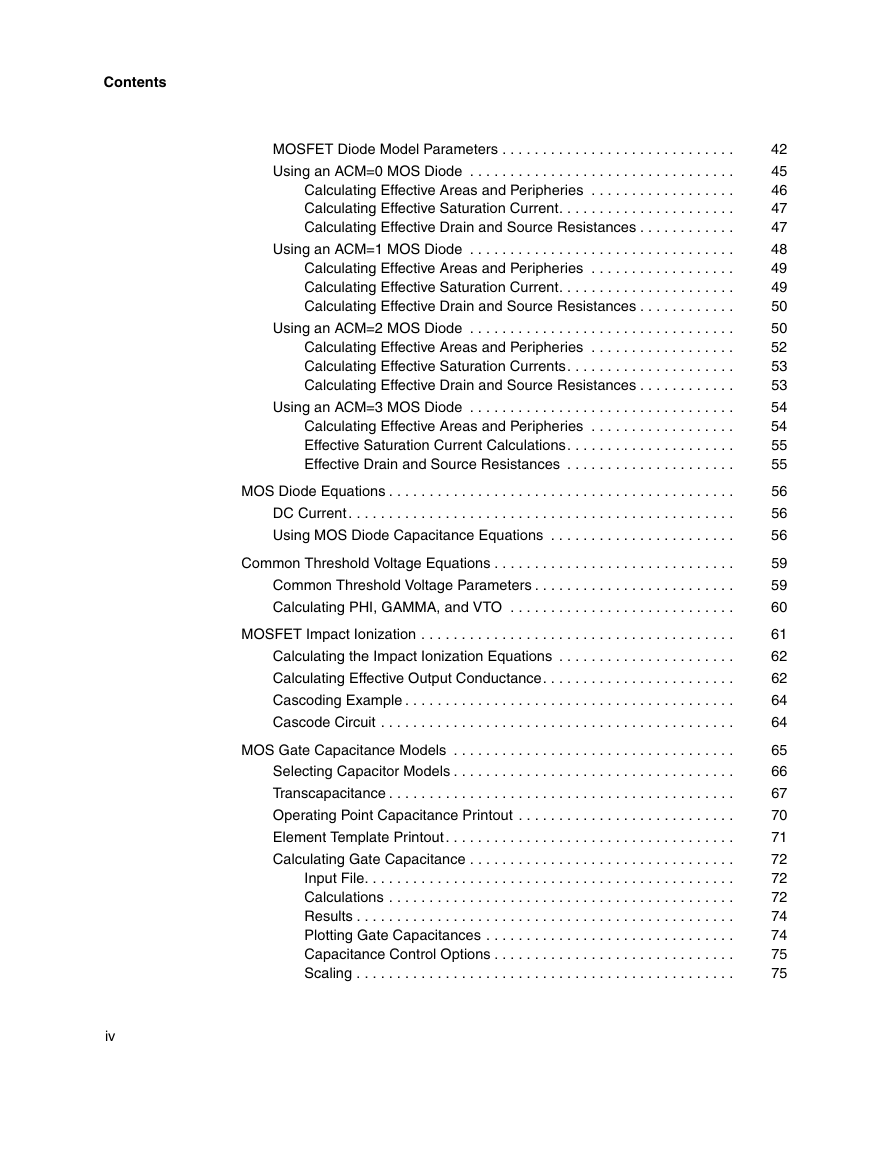
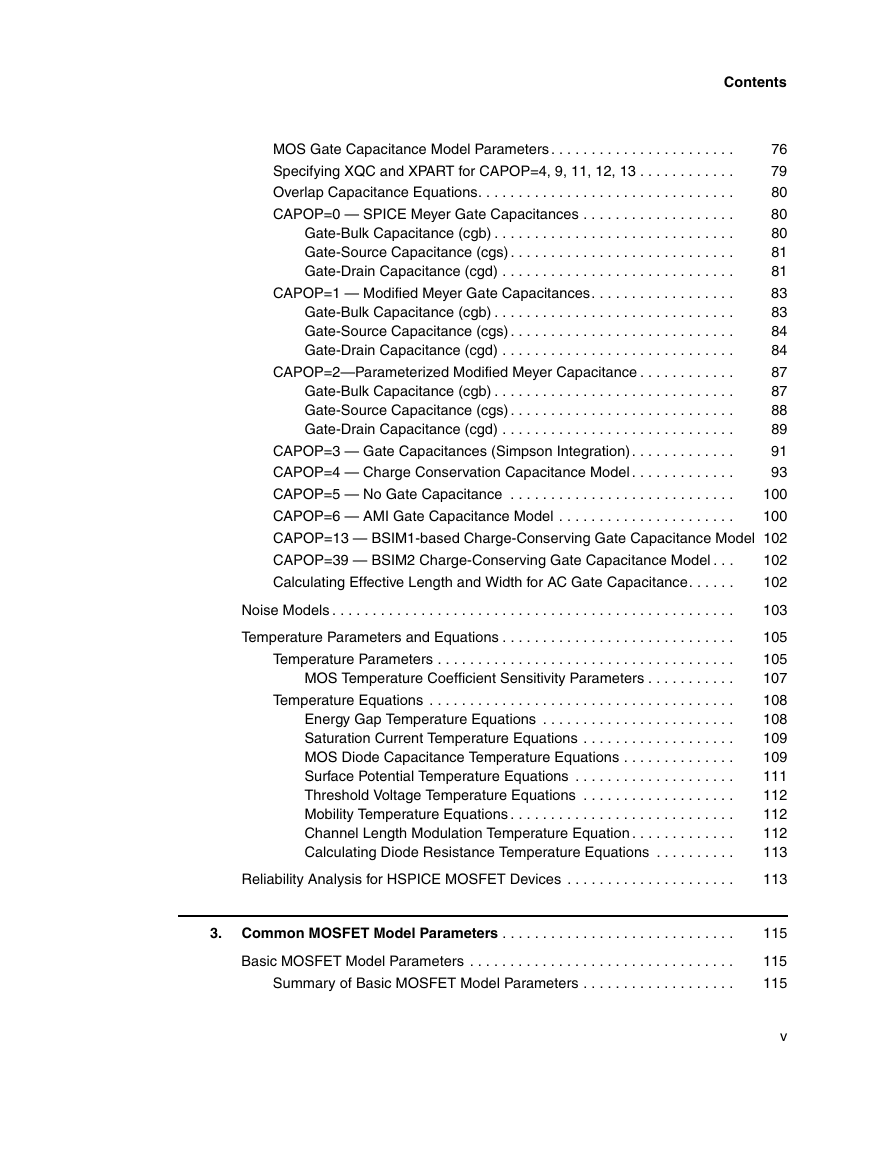
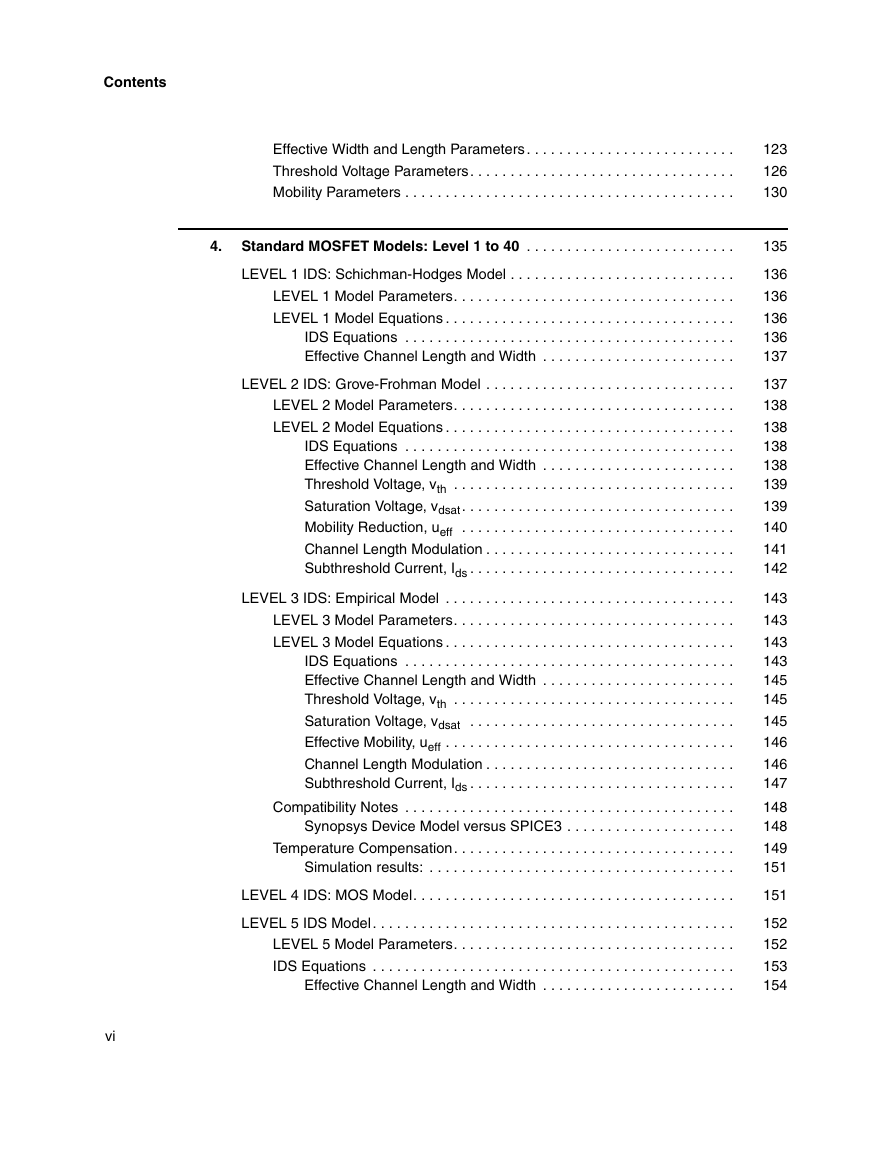

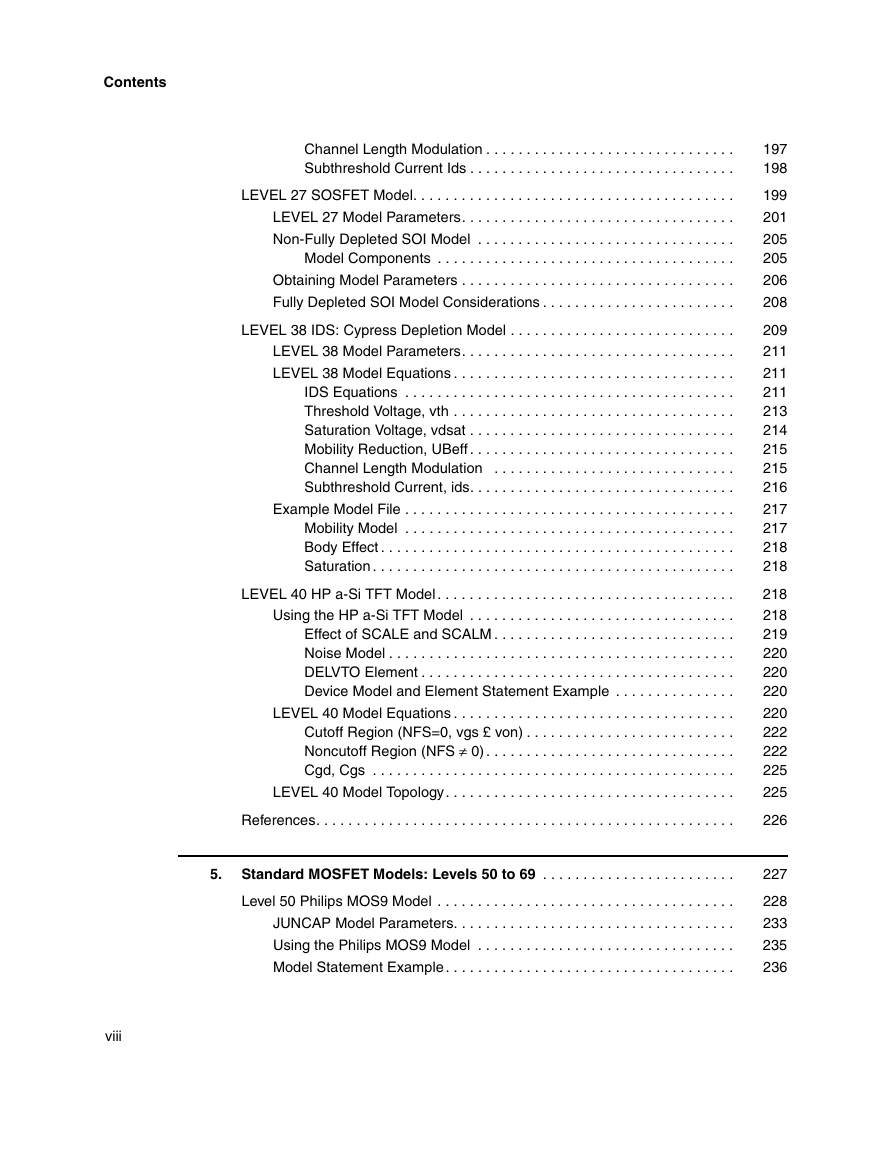








 2023年江西萍乡中考道德与法治真题及答案.doc
2023年江西萍乡中考道德与法治真题及答案.doc 2012年重庆南川中考生物真题及答案.doc
2012年重庆南川中考生物真题及答案.doc 2013年江西师范大学地理学综合及文艺理论基础考研真题.doc
2013年江西师范大学地理学综合及文艺理论基础考研真题.doc 2020年四川甘孜小升初语文真题及答案I卷.doc
2020年四川甘孜小升初语文真题及答案I卷.doc 2020年注册岩土工程师专业基础考试真题及答案.doc
2020年注册岩土工程师专业基础考试真题及答案.doc 2023-2024学年福建省厦门市九年级上学期数学月考试题及答案.doc
2023-2024学年福建省厦门市九年级上学期数学月考试题及答案.doc 2021-2022学年辽宁省沈阳市大东区九年级上学期语文期末试题及答案.doc
2021-2022学年辽宁省沈阳市大东区九年级上学期语文期末试题及答案.doc 2022-2023学年北京东城区初三第一学期物理期末试卷及答案.doc
2022-2023学年北京东城区初三第一学期物理期末试卷及答案.doc 2018上半年江西教师资格初中地理学科知识与教学能力真题及答案.doc
2018上半年江西教师资格初中地理学科知识与教学能力真题及答案.doc 2012年河北国家公务员申论考试真题及答案-省级.doc
2012年河北国家公务员申论考试真题及答案-省级.doc 2020-2021学年江苏省扬州市江都区邵樊片九年级上学期数学第一次质量检测试题及答案.doc
2020-2021学年江苏省扬州市江都区邵樊片九年级上学期数学第一次质量检测试题及答案.doc 2022下半年黑龙江教师资格证中学综合素质真题及答案.doc
2022下半年黑龙江教师资格证中学综合素质真题及答案.doc